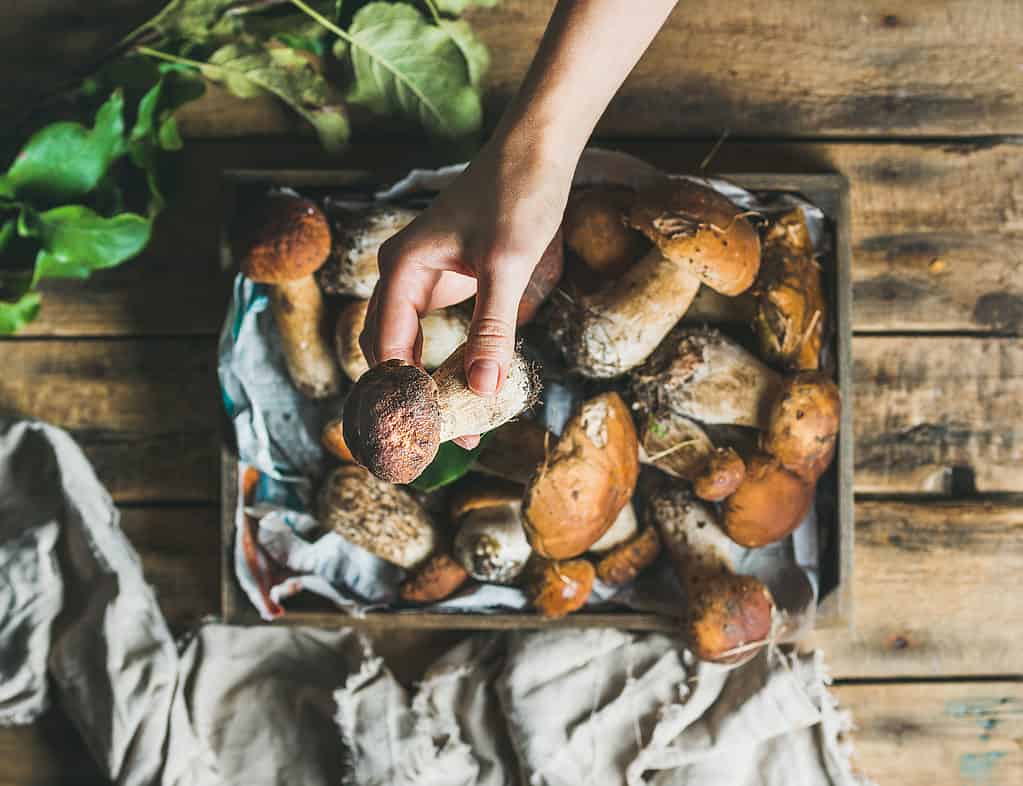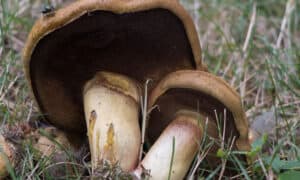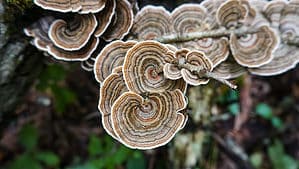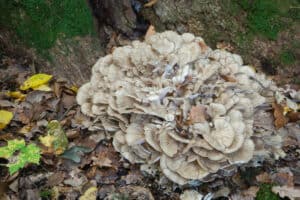Porcinis are a delicious and rather expensive choice mushroom well-loved for their savory taste and meaty texture. Porcini mushrooms can often cost $55-$70 per pound, knowing that you may be wondering if you can simply cultivate them.
In this guide, we’ll cover the fungal classification of porcini mushrooms. We will also cover their characteristics, where and how they grow, and if it’s feasible to grow porcini mushrooms.
Alright, let’s get to it!
Porcini Mushrooms: Fungal Classification
While “porcini” can be synonymous with the king bolete, Boletus edulis, it can also refer to a number of similar species in the Boletus genus. For this article, we’ll refer to porcini as Boletus edulis. As its common and scientific name suggests, Boletus edulis belongs to the Boletales order of fungi. Within this order, there are at least 15 families, 90 genera, and about 1,400 species. Species in the Boletus genus belong to one of the more commonly known bolete families, the Boletaceae.
Within the order Boletales the vast majority of boletes are identified by having soft, vertical tube-like structures as their spore-bearing tissues, rather than gills. We call these structures pores. However, there are a small number of boletes that have gills! These are known as gilled boletes, and most of them are found in the Phylloporus genus. Besides most boletes containing pores there are a few other things to look for. Other key features of a bolete include a stem-and-cap fruiting body structure, that often have a swollen stem (aka stipe). They also have a sponge-like surface underneath the cap.
Porcinis: Native Range, Characteristics, and Ecology
Before we talk about if you can grow porcinis, it’s important to understand where they grow in the wild, their characteristics, and the ecological roles they serve in our environment.
Native Range
Where, for certain, Boletus edulis is native to, is currently under discussion as there are many species within the Boletus genus that appear to fit the macro description of the king bolete. Genetic studies are helping to clarify. For now, it appears that B. edulis and it’s allies are mostly native to temperate and subtropical regions of Europe, Northeastern Asia, and North America.
Characteristics
Mycophiles often consider porcinis to be the choicest of edible boletes and some of the most highly prized mushrooms in general. Folks describe these large mushrooms as meaty in taste and texture with a complex, earthy, and nutty flavor that gives them a strong umami quality. Many people describe fresh porcinis as having a faint, pleasant smell. Below, we’ll cover identifying characteristics of the fruiting body of Boletus edulis.
Cap
The porcini features a large, greasy or tacky cap. Underneath the cap you will find a white pore surface that turns greenish-yellow or brown with age. These pores are “stuffed” when young. The flesh of the mushroom does not change color when cut or exposed to air, this is an important tool for identification as some similar looking but toxic species stain blue when cut. The cap color and size depend on the variety of B. edulis, such as B. edulis var. grandedulis. Cap size typically ranges from 4 to 20 inches across. The cap color is usually either light brown, red-brown, or yellow-brown depending on species. When young, the cap is convex, although it will expand outward with age.
Stipe
The stipe of the porcini mushroom is swollen and fleshy, often club-shaped, and usually features a dusting of cinnamon brown over white. If you look closely, you should see a fine net-like pattern that is called reticulation. The interior flesh is solid, white, and does not change color when cut or exposed to air. The stipe can range from 2.5-8 inches tall and up to about 3 inches thick.

Porcini mushrooms in a basket
©Foxys Forest Manufacture/Shutterstock.com
Ecology
Here’s where we’ll really get into why there are no commercial porcini growing operations.
The vast majority of boletes, including Boletus edulis, are mycorrhizal fungi. This means that they survive by forming a beneficial plant-fungi relationship. In this relationship they provide essential nutrients to the root of their host plant in exchange for metabolites. This mycorrhizal partnership is essential to the health of both the plant and fungus. Porcini can form this symbiotic relationship with a number of trees including conifers such as spruce, pine, fir, and hemlock. They can also have relationships with hardwoods such as oak, chestnut, and beech.
Is It Possible to Grow Porcini Mushrooms?
So, it is possible, then, to cultivate porcinis? It may be possible, although there are no documented successful attempts, including by researchers with an abundance of resources and knowledge. This is why porcinis are so expensive, as they cannot yet be cultivated commercially in mass and are only wild-harvested. You may find businesses trying to sell grow kits online, but be aware that these are likely scams no matter what they claim. It’s important to understand that the process of growing any mycorrhizal mushroom is much more involved, complex, and time-consuming than growing saprobic mushrooms, which account for over almost all of cultivated mushrooms. This is especially true for the cultivation of epigeous, or aboveground-fruiting mycorrhizal mushrooms, as opposed to hypogeous (underground-fruiting) mycorrhizal mushrooms like truffles.
In Japan, a group successfully cultivated a few fruiting bodies of mycorrhizal chanterelle mushrooms by producing a pure mycelial culture in a laboratory-controlled setting and directly inoculating the root tips of an appropriate host tree seedling. This process still required a 2-year incubation period under constantly controlled light and temperature conditions.
So, the bottom line is that if you’re interested in growing mushrooms at home, you’re far better off growing species that are widely cultivated and beginner-friendly, such as oyster mushrooms!
The photo featured at the top of this post is © All for you friend/Shutterstock.com
The information presented on or through the Website is made available solely for general informational purposes. We do not warrant the accuracy, completeness, or usefulness of this information. Any reliance you place on such information is strictly at your own risk. We disclaim all liability and responsibility arising from any reliance placed on such materials by you or any other visitor to the Website, or by anyone who may be informed of any of its contents. None of the statements or claims on the Website should be taken as medical advice, health advice, or as confirmation that a plant, fungus, or other item is safe for consumption or will provide any health benefits. Anyone considering the health benefits of particular plant, fungus, or other item should first consult with a doctor or other medical professional. The statements made within this Website have not been evaluated by the Food and Drug Administration. These statements are not intended to diagnose, treat, cure or prevent any disease.
Thank you for reading! Have some feedback for us? Contact the AZ Animals editorial team.






